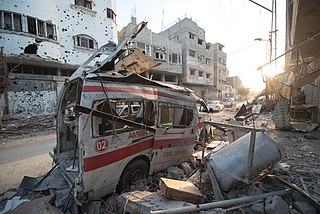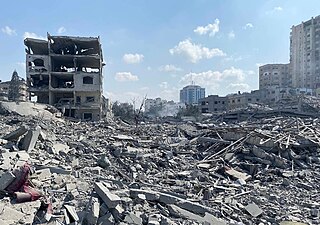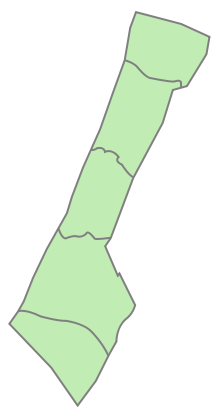
The Second Intifada, also known as the Al-Aqsa Intifada, was a major uprising by Palestinians against Israel, characterized by a period of heightened violence in the Palestinian territories and Israel between 2000 and 2005. The general triggers for the unrest are speculated to have been centered on the failure of the 2000 Camp David Summit, which was expected to reach a final agreement on the Israeli–Palestinian peace process in July 2000. An uptick in violent incidents started in September 2000, after Israeli politician Ariel Sharon made a provocative visit to the Al-Aqsa compound, which is situated atop the Temple Mount in East Jerusalem; the visit itself was peaceful, but, as anticipated, sparked protests and riots that Israeli police put down with rubber bullets, live ammunition, and tear gas. Within the first few days of the uprising, the IDF had fired one million rounds of ammunition.
Mohammed Deif, born Mohammed al-Masri, is a Palestinian militant and the head of the Izz ad-Din al-Qassam Brigades, the military wing of the Islamist organization Hamas.

The Popular Resistance Committees is a coalition of a number of armed Palestinian groups opposed to what they regard as the conciliatory approach of the Palestinian Authority and Fatah towards Israel.
The Izz ad-Din al-Qassam Brigades, named after Izz ad-Din al-Qassam, is the military wing of the Palestinian organization Hamas. Currently led by Mohammed Deif, IQB is the largest and best-equipped militant group operating within Gaza today.

The 2006 Gaza–Israel conflict, known in Israel as Operation Summer Rains, was a series of battles between Palestinian militants and the Israel Defense Forces (IDF) during summer 2006, prompted by the capture of Israeli soldier Gilad Shalit by Palestinian militants on 25 June 2006. Large-scale conventional warfare occurred in the Gaza Strip, starting on 28 June 2006, which was the first major ground operation in the Gaza Strip since Israel's unilateral disengagement plan was implemented between August and September 2005.
The Gaza–Israel conflict is a localized part of the Israeli–Palestinian conflict beginning in 1948, when 200,000 Palestinians fled or were expelled from their homes, settling in the Gaza Strip as refugees. Since then, Israel has fought 15 wars against the Gaza Strip. The number of Gazans reportedly killed in the most recent 2023 war — 34,000 — is higher than the death toll of all other wars of the Arab-Israeli conflict.

The Gaza War, also known as Operation Cast Lead, also known as the Gaza Massacre, and referred to as the Battle of al-Furqan by Hamas, was a three-week armed conflict between Gaza Strip Palestinian paramilitary groups and the Israel Defense Forces (IDF) that began on 27 December 2008 and ended on 18 January 2009 with a unilateral ceasefire. The conflict resulted in 1,166–1,417 Palestinian and 13 Israeli deaths. Over 46,000 homes were destroyed in Gaza, making more than 100,000 people homeless.
Roof knocking or "knock on the roof" is a term used by the Israel Defense Forces (IDF) to describe its practice of dropping non-explosive or low-yield devices on the roofs of targeted civilian homes in the Palestinian territories as a prior warning of imminent bombing attacks to give the inhabitants time to flee the attack. The practice was employed by the IDF during the 2008–2009 Gaza War, the 2012 Israeli operation in the Gaza Strip, and the 2014 Gaza War to target the homes of police officers or Hamas political or military leaders.
Accusations of violations regarding international humanitarian law, which governs the actions by belligerents during an armed conflict, have been directed at both Israel and Hamas for their actions during the 2008–2009 Gaza War. The accusations covered violating laws governing distinction and proportionality by Israel, the indiscriminate firing of rockets at civilian locations and extrajudicial violence within the Gaza Strip by Hamas. As of September 2009, some 360 complaints had been filed by individuals and NGOs at the prosecutor's office in the Hague calling for investigations into alleged crimes committed by Israel during the Gaza War.

The 2010 Gaza clashes were military clashes in the Gaza Strip between Israeli forces and Palestinian armed groups that occurred in March 2010.
Marwan Abdel Karim Ali Issa was a Palestinian militant who was the deputy commander of Hamas' military wing, the Izz ad-Din al-Qassam Brigades.

The al-Aqsa Martyrs' Brigades is a coalition of Palestinian armed groups in the West Bank. The organization has been designated as a terrorist organization by Israel, the European Union, Canada, Japan, New Zealand, and the United States.

The 2014 Gaza War, also known as Operation Protective Edge, and Battle of the Withered Grain, was a military operation launched by Israel on 8 July 2014 in the Gaza Strip, a Palestinian territory that has been governed by Hamas since 2007. Following the kidnapping and murder of three Israeli teenagers in the West Bank by Hamas-affiliated Palestinian militants, the Israel Defense Forces (IDF) initiated Operation Brother's Keeper, in which some 350 Palestinians, including nearly all of the active Hamas militants in the West Bank, were arrested. Hamas subsequently fired a greater number of rockets into Israel from the Gaza Strip, triggering a seven-week-long conflict between the two sides. It was one of the deadliest outbreaks of open conflict between Israel and the Palestinians in decades. The combination of Palestinian rocket attacks and Israeli airstrikes resulted in over two thousand deaths, the vast majority of which were Gazan Palestinians. This includes a total of six Israeli civilians who were killed as a result of the conflict.

The Battle of Shuja'iyya occurred between the Israel Defense Forces and the Izz ad-Din al-Qassam Brigades on 20 July 2014 during 2014 Israel–Gaza conflict in the Shuja'iyya neighborhood of Gaza City, in the Gaza Strip. Shuja'iyya, with 92,000 people in 6 sq-kilometres, is one of the most densely populated areas of the Gaza Strip. According to the IDF, it had become a "terrorist fortress", that between 8 and 20 July had fired over 140 rockets into Israel after the outbreak of hostilities. Casualty figures are not known with precision, partly because bodies were recovered long after the fighting, and people had also died of injuries afterwards. The UN Protection Cluster states that between the 19-20th, 55 civilians, including 19 children and 14 women, were killed as a result of the IDF's actions. At the time, estimates varied from 66 to about 120 Palestinians killed, with a third of them women and children, and at least 288 wounded. The UN figures of Palestinian casualties are preliminary and subject to revision. 16 Israeli soldiers were killed.

Yahya Sinwar, also spelled Yehya Sinwar, is a Palestinian politician who has been leader of Hamas, the Sunni Islamist political and military organization that rules the Gaza Strip, since 2017.

Israeli war crimes are the violations of international criminal law, including war crimes, crimes against humanity and the crime of genocide, which the Israel Defense Forces, the military branch of the state of Israel, has been accused of committing since the founding of Israel in 1948. These have included murder, intentional targeting of civilians, killing prisoners of war and surrendered combatants, indiscriminate attacks, collective punishment, starvation, the use of human shields, sexual violence and rape, torture, pillage, forced transfer, breach of medical neutrality, targeting journalists, attacking civilian and protected objects, wanton destruction, incitement to genocide, and genocide.

The bombing of the Gaza Strip is an ongoing aerial bombardment campaign on the Gaza Strip by the Israeli Air Force during the Israel–Hamas war. During the bombing, Israeli airstrikes damaged Palestinian refugee camps, schools, hospitals, mosques, churches, and civilian infrastructure.
During the Israel–Hamas war, the Israel Defense Force (IDF) used artificial intelligence to rapidly and automatically perform much of the process of determining what to bomb. Israel greatly expanded the bombing of the Gaza Strip, which in previous wars had been limited by the Israeli Air Force running out of targets.

Hamas war crimes are the violations of international criminal law, including war crimes and crimes against humanity, which the Islamist Nationalist organization Hamas and its paramilitary wing, the al-Qassam Brigades have been accused of committing. These have included murder, intentional targeting of civilians, killing prisoners of war and surrendered combatants, indiscriminate attacks, the use of human shields, rape, torture and pillage.














